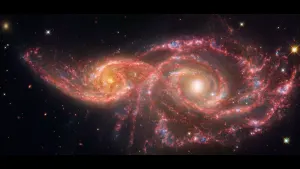
Scientists discover a black hole that shouldn't exist
A group of U.S. astronomers have unexpectedly spotted a supermassive black hole with a thin disk that is approximately 130 million light-years from Earth in heart of the spiral galaxy NGC 3147. This discovery not only adds to the mystery of black holes but challenges current astronomical theories because it technically should not exist.
The July edition of NASA's Newsletter explains that the Hubble Space Telescope detected a thin disk of material rapidly whirling around the black hole and states that this should not be possible based on Albert Einstein's theories of relativity.
The newsletter explains that black holes in certain types of galaxies, such as NGC 3147, are malnourished because there is not enough gravitationally captured material that can regularly feed them, which would cause this material to "puff up like a donut rather than flattening out in a pancake-shaped disk." The thin, flat disk that was detected with this black hole resembles those that are found in more active galaxies that are filled with "engorged, monster black holes."

An artistic interpretation of a black hole. Credit: Wikimedia Commons
This supermassive black hole weighs approximately 250 million times more than the Sun and the Hubble Space Telescope recorded material spinning around it at more than 10 per cent of the speed of light, or 29,979 kilometres per second.
Albert Einstein's general theory of relativity first predicted the existence of black holes in 1916 and the first image of a black hole ever captured was released in April 2019. Since black holes have gravitational accelerations that are so powerful that nothing can escape it, including electromagnetic radiation such as light, scientists struggled to capture an image of one.
A team of more than 200 researchers were able to create the first image of a black hole from an elliptical galaxy called M87, 53 million light years away. The black hole was about 6.5 billion solar masses.

This first-ever image of a black hole, captured using the Event Horizon Telescope, shows the supermassive black hole that lies at the centre of the galaxy M87. Credit: Event Horizon Telescope Collaboration
While black holes themselves are unseeable because they trap light, the image shows the black hole's event horizon, which is considered the "point-of-no-return" boundary within which nothing can be seen and nothing can escape because the speed needed to leave the event horizon would need to be equal or greater than the speed of light, which is impossible according to current astronomical theories.
Source: NASA









